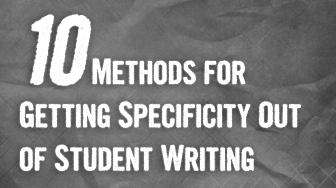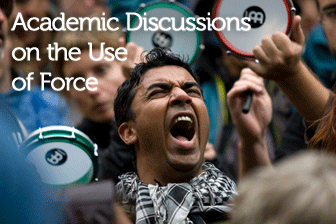An Issue for Society: Getting More Specificity Out of Writing


Indeed, “The Anonymous Protester” was Time Magazine’s Person of the Year. I mentioned to my husband, a veteran of the 1960’s protests, that there seemed to be parallels between the Occupy Movement, which began as a protest against Wall Street and quickly spread around the world, and the civil disobedience so prevalent in the 1960s; he snorted and said that the 1960’s protests had a point. While it may be that the 1960’s protests were more focused on specific social ills such as segregation, it seems to me both protest movements, of the ‘60s and today, have a discontent directed at authority—authority gone awry. It’s probably not coincidental that the young adult generation involved in the current protest movement—the generation in our classrooms, in other words—would be mostly children of the 1960’s protesters.
So how does all of this relate to our classrooms? It’s very relevant—in terms of discussing issues of human rights, of use of force, about appropriate and non-appropriate rebellion against authority.
This was all driven home one afternoon last fall, when I was in my ESL reading class, discussing the scheduled reading, George Orwell’s “Shooting an Elephant,” his classic essay on the misuse of power. In this essay, Orwell was serving as a British Empire police officer in Burma and was forced into killing an elephant—when he didn’t want to, when he was the “white man with the gun,” the person supposedly in power, and when the elephant was harming no one at the moment—all to avoid loss of face in front of the Burmese. Coincidentally, we were reading this essay the day after a now-infamous event at nearby University of California, when in a videotape that went viral, campus police pepper-sprayed a group of student protesters who were passively sitting on the quad.
The protest movement has material on the use of force and of democracy ripe for discussion, reading, and writing.

Who was “right”? Is there always a “right” and “wrong” party in events like this? Who will probably end up taking the blame, and should he or she take the blame?
Does context matter in the problem? Does past behavior, the surroundings, what the victim “might” do or has done count? Does it matter, for example, that the elephant had already killed someone? Did it matter in the pepper-spray incident that the Thanksgiving weekend was approaching; it was cold out; services would be closed, and therefore the campus administration not without reason wanted the protesters to dismantle their camp, and they refused?
What alternatives were there? What should or could the aggressor have done instead? The victim? Should the protesters at UC simply have moved when asked? What could the police have done before spraying them? What more could Orwell have done before resorting to using a gun?
Are there any absolute wrongs in the matter of use of force? Should people always obey police, for example, whether or not they agree with them?
What do incidents like the event at UC say about democracy? Is it merely an anomaly, or is does this event show our democracy is in peril in some way?

Opening the dialogue. What do you think about the events at UC last week? Sometimes students have an “I-don’t-want-to-talk-about-this-what-does-it-have-to-do-with-the-class” attitude. Often this attitude is based on a fear of “getting in trouble” in some way. Be patient and persistent; make the connection to the reading explicit, briefly, if necessary. Allow different students to speak, and show the fear is baseless.
Often students have already formed a set opinion on the reading or event: “The Occupiers should have moved when the police told them to. They’re just irritating and have nothing better to do.” Gently questioning and pushing against these assumptions: “Were the participants in the Boston Tea Party ‘irritating’ to anyone? Perhaps that is their tactic? And does irritation give the police license in the level of force used?” can further stimulate discussion.
Break students into groups. Once the discussion has started, the teacher can break the class into smaller groups of three or so, each group getting its own set of pre-typed questions on the topic. Within the group, students can assign roles such as leader, to keep discussion going; recorder, to take notes to be collected for participation points; spokesperson, to share with the class when called on, and so forth. This gives students a task to accomplish and each student a role. Discussion like this can easily take up a class period. If the teacher has not prepared questions because of the timeliness of the current event, just a single question on the board is often enough: “What could the police have done differently?” Ask the students to come to consensus in their groups.
Wrap up, debrief. Call the class back together as a whole. Go over main points that were discussed in each group as time allows. Collect notes from each group as desired for participation points.
Writing topics. Once students have discussed the topic, they can now write about it. I see writing in this case as an extension of the discussion begun in class. Students already may have settled on a topic from discussion they really are passionate about: another benefit to discussing these kinds of topics is the joy of seeing the formerly apathetic student suddenly enthused. In this case, if the discussion topic is an appropriate writing topic, I’ll let the student write to that.
Guidelines for writing topics: the topics should be specific enough to generate interest but also broad enough for critical thinking. For example: What are your ideas about the use of force? When is it appropriate? When not? Support with your own experiences and ideas drawn from the reading and discussion in an essay response. The essay should be of 500 words with a thesis and supporting paragraphs. Giving students specific guidelines like this allows them to develop their own ideas yet in academic format.
Controversy, after all, is what we tend to get passionate about. And who wants to discuss or write about something they are not passionate about?